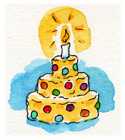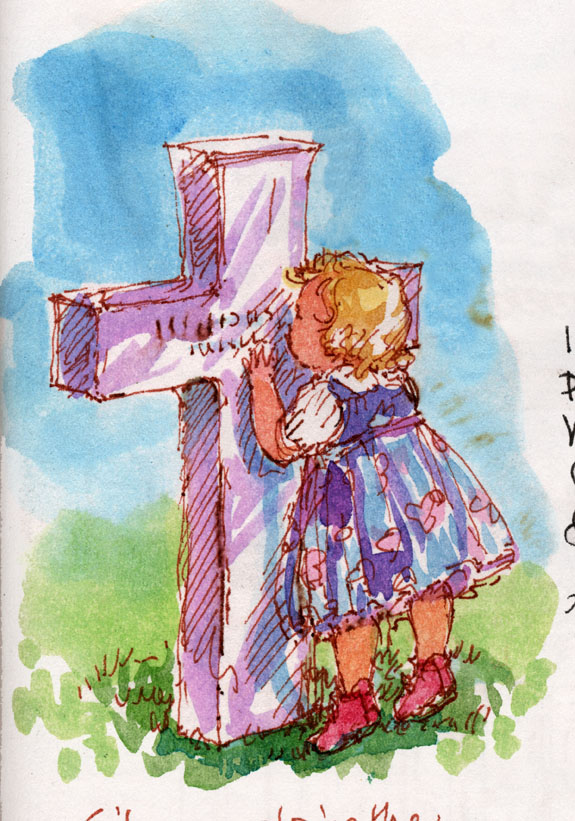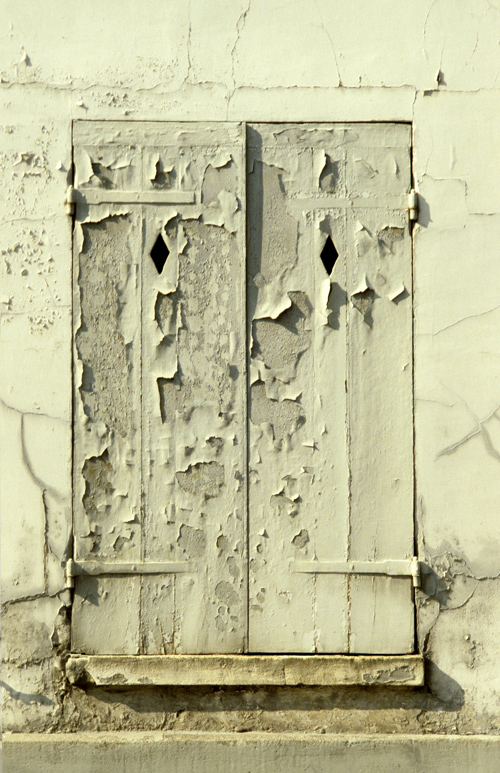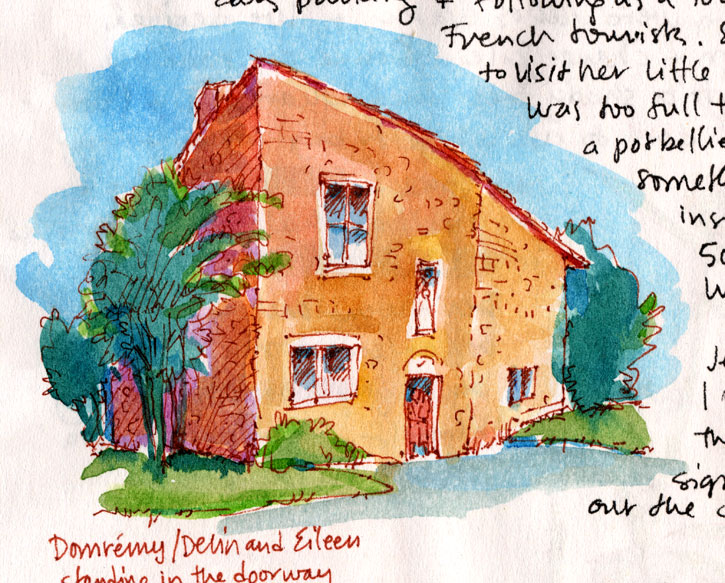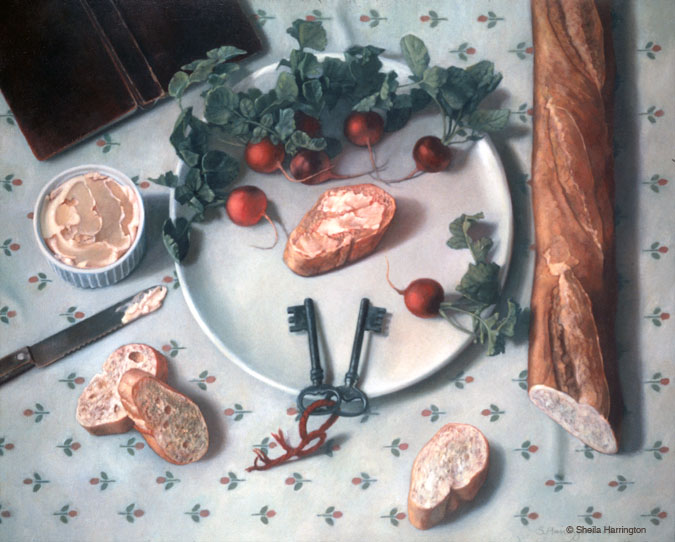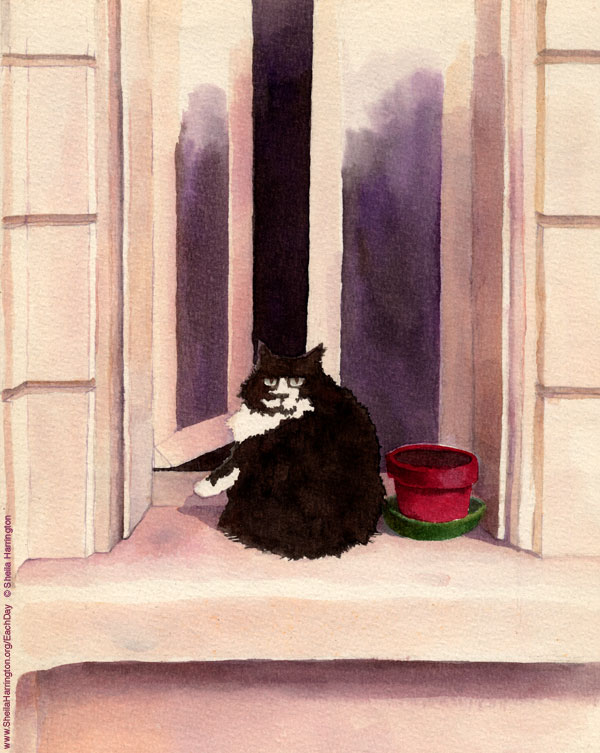Tag: France
Living in Gabian
In Memoriam
When my daughter was eighteen months old, our family made a visit to the American cemetery at Epinal in eastern France, where my Uncle Doug, a WWII pilot, is buried. For reasons mysterious to us (she didn’t really talk much until age three), she left our side to make her own private pilgrimage among the tombstones, kissing each one before moving on to the next.
We’ll always have Paris
My husband, a fellow artist, has recently launched a blog to show a selection of his art—photographs, drawings, paintings, and sculpture—and he is now permitting me to share the news. I encourage you to check out his beautiful and varied work. This is an image from today’s post.
A Glimpse of Tolerance
Today is the anniversary of the enactment of the Edict of Nantes, a modest 16th-century attempt at freedom of worship. For a sketch and a mini-history, please see One Small Step for l’Homme.
Déjeuner of the Dragon
I hope you have paid your debts, hung your lucky couplets on the door, swept your house clean of ill-fortune, and decked it and yourself in red, because today is the first day of Chinese New Year celebrations, and you have fifteen days of festivities ahead of you. Our own culinary interpretation of this holiday: tonight I will make crispy tofu and stir-fried broccoli and ginger but will order spicy eggplant and vegetarian dumplings from Mr. Chen’s Organic Chinese Restaurant around the corner. We’ve already prepared our New Year fortunes—more on that later.
2012 is the Year of the Dragon, and if you were born in a Dragon year, you are (according to Mr. Chen’s placemats) eccentric, and your life complex. You have a very passionate nature and abundant health. Marry a Monkey or Rat late in life, and avoid the Dog!
Today is also the birthday of painter Édouard Manet (1832-1883), who was himself born in the Year of the Dragon. I hope that, in addition to his other qualities, he had a sense of humor.
Maid of Orléans
No one really knows precisely when Joan of Arc was born. But January 6, 1412 is traditionally recognized as the date, making today the 500th anniversary of her birth, the quincentennial celebration of her mysterious, heroic, and too-short life.
The outlines of the story are generally recognized: A pious girl from a rural family, in response to visions and voices she explained as those of saints and angels, approached the Dauphin, the future Charles VII, during the Hundred Years’ War, and convinced him to allow her to aid France.
Given a suit of armor and a banner with fleur-de-lis, she led newly-inspired French troops (who had formerly declined to follow the feckless and irresolute Charles into battle) to expel the English and Burgundians from her then-small country. Her successes in battle, and in eventually arranging for the coronation of the Dauphin in Reims, greatly encouraged the French, but alarmed the Burgundians and infuriated the English, who, when they finally had Joan in custody, burned her at the stake as heretic and witch and raked her ashes into the Seine to prevent the collection of relics—an indication of awareness that they had murdered an innocent. She was nineteen. Detailed records of her trial, painstakingly kept by the court, reveal to us Joan’s simplicity and humility, in contrast to the narrow-minded and vengeful scheming of her assorted judges.
These same records were made use of to acquit her posthumously later under Charles’ rule—for him it was politically expedient to have been crowned with the aid of a courageous maiden instead of a condemned witch. During the acquittal process the testimony of numerous witnesses reveals the original trial’s illegal and corrupt maneuverings.
How was an untrained teenage country girl able to lead dispirited soldiers in the wake of a string of defeats (notably Agincourt in 1415) to win a series of battles and break through enemy lines to see her king crowned? What was the nature of Joan’s voices? To this day much of her story remains unknown and a subject of speculation for historians, psychotherapists, artists, novelists, playwrights, and filmmakers. Statues of Joan are to be found all over the world, including here in Washington, DC, a gift from the Ladies of France in Exile in New York in 1922 and the only equestrian statue of a woman in the city. (There are actually only a handful of equestrian statues of women to be found anywhere, and probably more of Joan of Arc than any other.) As of 1920, Joan became—after five hundred years (the Catholic church moving with its customary excruciating slowness)—Saint Joan.
The image of Jeanne d’Arc has been co-opted, ironically, by the French extreme right, who more properly ought to take as their symbol a 15th-century right-winger: the manipulative and self-absorbed Duke of Burgundy, who turned Joan over to the English to maintain his power; the misogynist cleric Pierre Cauchon, who was fixated on Joan’s wearing of male attire; or the avaricious English themselves, whose desire for the French throne had been humiliatingly waylaid by an upstart female. The ultra-conservative Front National is no place for unconventional Joan, who defied societal expectations, suffered in battle and in prison, and died for her efforts.
The sketch is from a visit to the house in Domrémy thought to have belonged to Joan’s family.
Today is also the Feast of the Epiphany, the day on which, according to tradition, three wise men from the East carried gifts to the infant Jesus. For another take on this event, please see The Three Wise Women.
The Feast of the Epiphany is also the birthday of Carl Sandburg (1878-1967). For a comic and a poem, please see Poetic Journey of the Magi.
Bastille Day
In honor of the day I post this painting, featuring, among other things, our ratty yet beloved old Paris guide to arrondissements. This morning we hung from the porch our homemade French flag and put Edith Piaf on the CD player. For dinner I will make a soufflé (not exactly a dish suited to July, but definitely a family favorite) and we’ll watch “Casablanca” and sing along during the Marseillaise scene. Vive la France!
This image is available as a high-resolution print on 8.5″ x 11″ archival paper.
À la recherche du temps perdu
Cats
This rather fierce-looking cat is Minou, the spoiled darling of the concierge, painted in our long-ago Paris days. Minou is undoubtedly long gone, but she pretty much ruled the roost while she was around. I post her portrait here, along with this poem, in honor of Eleanor Farjeon (1881-1965), whose birthday it is today. For a brief bio of the delightful Farjeon, another of her poems, and a painting, please see Morning Has Broken.
Cats sleep Anywhere, Any table, Any chair, Top of piano, Window-ledge, In the middle, On the edge, Open drawer, Empty shoe, Anybody’s Lap will do, Fitted in a Cardboard box, In the cupboard With your frocks – Anywhere! They don’t care! Cats sleep Anywhere.—Eleanor Farjeon



